高中英语阅读理解教案
【公开课教案及学案】高考英语阅读理解-词义猜测
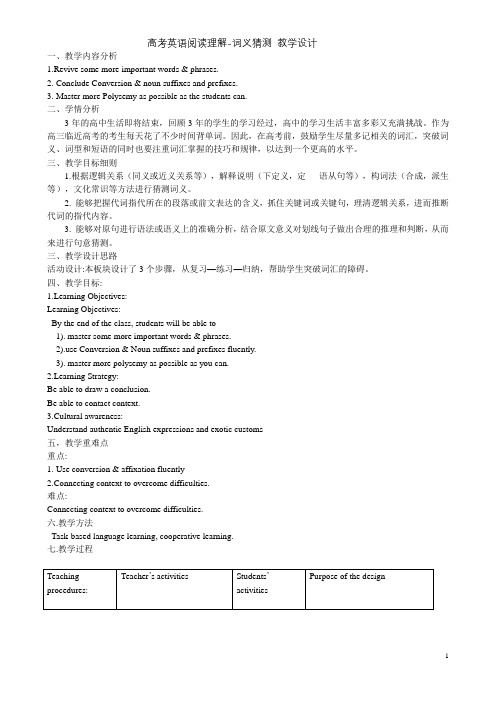
高考英语阅读理解-词义猜测教学设计一、教学内容分析1.Revive some more important words & phrases.2. Conclude Conversion & noun suffixes and prefixes.3. Master more Polysemy as possible as the students can.二、学情分析3年的高中生活即将结束,回顾3年的学生的学习经过,高中的学习生活丰富多彩又充满挑战。
作为高三临近高考的考生每天花了不少时间背单词。
因此,在高考前,鼓励学生尽量多记相关的词汇,突破词义、词型和短语的同时也要注重词汇掌握的技巧和规律,以达到一个更高的水平。
三、教学目标细则1.根据逻辑关系(同义或近义关系等),解释说明(下定义,定语从句等),构词法(合成,派生等),文化常识等方法进行猜测词义。
2. 能够把握代词指代所在的段落或前文表达的含义,抓住关键词或关键句,理清逻辑关系,进而推断代词的指代内容。
3. 能够对原句进行语法或语义上的准确分析,结合原文意义对划线句子做出合理的推理和判断,从而来进行句意猜测。
三、教学设计思路活动设计:本板块设计了3个步骤,从复习—练习—归纳,帮助学生突破词汇的障碍。
四、教学目标:1.Learning Objectives:Learning Objectives:By the end of the class, students will be able to1). master some more important words & phrases.2).use Conversion & Noun suffixes and prefixes fluently.3). master more polysemy as possible as you can.2.Learning Strategy:Be able to draw a conclusion.Be able to contact context.3.Cultural awareness:Understand authentic English expressions and exotic customs五,教学重难点重点:1. Use conversion & affixation fluently2.Connecting context to overcome difficulties.难点:Connecting context to overcome difficulties.六.教学方法Task-based language learning, cooperative learning.七.教学过程高考阅读---词义猜测2023泉州三模CAnother study by the Think Wood campaign concludes that nature can have a beneficial effect on creativity, concentration and well-being. Not only do cool-looking biophilic offices help companies recruit(招聘) talent in an incredibly tight labor market, but they also nudge the new talent to perform better at work.(2023泉州三模)33. What does the underlined word “nudge”in paragraph 4 mean?A. Encourage.B. Anticipate.C. Remind.D. Promise2023广东二模 CClare says the concept has been used for years in different ways. Scientists sample pathogens(病原体) from the air, which has been used to help track COVID-19. Environmental DNA can also be collected from water to help ease invasive species.33. What does the underlined phrase “the concept”in paragraph 3 refer to?A. Detecting danger in the air.B. Protecting endangered animals.C. Sucking DNA out of the air.D. Collecting environmental samples.CYesterday, after a day of Zoom (视频会议软件) meetings in my living room, I stepped out for a walk, leaving my teen son bored on the couch. Bleecker Street, usually packed with people, was sprinkled with only the occasional pedestrians. Bars and restaurants lining the street were dark. Stores with bright neon lights, doors open, beckoned for the rare passers-by to enter. After just a week of the Covid-19 pandemic, an afternoon walk in Greenwich Village neighborhood felt surreal.But then I noticed a row of daffodils (水仙) reaching for the sun in the small triangle-shaped park by Minetta Lane. On the windows of a locked restaurant, in bright yellow paint, were the words “We love you, West Village. Take care of each other." My phone buzzed—a colleague, sent a picture of her newborn baby just home from the hospital. I arrived home to find my son animated on the couch playing a video game virtually with his friends. Life, love, play, and human connection persist, even though our world has been turned upside down.In my welcome note to the new students in the Fall, I wrote that this year is about ourcollege's core values of inclusion, innovation, and impact and emphasized the power of interconnection. Today,these core values persist, with interconnection taking on even greater significance. Our collaborative spirit has always given us an advantage-academically, creatively, culturally, and now, remotely.A wise person once told me that getting through a crisis is like being given a new hand of cards in the middle of a game. We are halfway through the semester, with new hands to play, but the game hasn't changed. We will find new ways to continue to work, teach, create, and learn. Let's also continue the informal interactions that make us a community-the study groups,coffee dates, drop-ins just to say hello. In doing so, we will remain connected.We will come together, from spaces around the world, to meet this new reality. This is who we are. Nothing not space,nor time can keep us from moving forward, together.28.What can he inferred from paragraph 1?A.The Covid-19 pandemic is unstoppable.B.The effects of the pandemic could he easily felt.C.Nothing is the same except that the business goes slow as usual.D.People have every reason to be worried about the future.29.What does the writer include in paragraph 2?A.Daily routines that seemed insignificant.B.Reminders that the world has been changed.C.Events that people can do during the pandemic.D.Things or people that carry symbolic meanings.30.What does the underlined word "collaborative" mean in paragraph 3?A.Cooperative.B.Pioneering.C.Independent.D.Adventurous.31..What is the main purpose of the text?A.To express wisdom gained from previous experience.B.To give people some tips on how to handle a crisis.C.To deliver an uplifting message over the pandemic.D.To encourage people to enjoy the great outdoors.。
高中英语阅读技巧教案英语阅读理解策略与方法
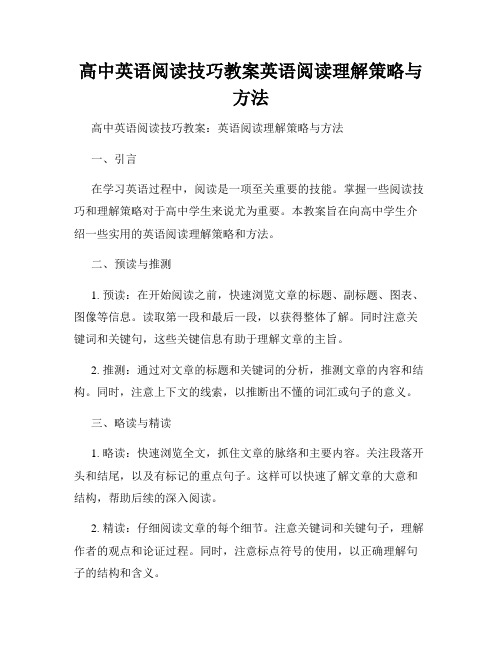
高中英语阅读技巧教案英语阅读理解策略与方法高中英语阅读技巧教案:英语阅读理解策略与方法一、引言在学习英语过程中,阅读是一项至关重要的技能。
掌握一些阅读技巧和理解策略对于高中学生来说尤为重要。
本教案旨在向高中学生介绍一些实用的英语阅读理解策略和方法。
二、预读与推测1. 预读:在开始阅读之前,快速浏览文章的标题、副标题、图表、图像等信息。
读取第一段和最后一段,以获得整体了解。
同时注意关键词和关键句,这些关键信息有助于理解文章的主旨。
2. 推测:通过对文章的标题和关键词的分析,推测文章的内容和结构。
同时,注意上下文的线索,以推断出不懂的词汇或句子的意义。
三、略读与精读1. 略读:快速浏览全文,抓住文章的脉络和主要内容。
关注段落开头和结尾,以及有标记的重点句子。
这样可以快速了解文章的大意和结构,帮助后续的深入阅读。
2. 精读:仔细阅读文章的每个细节。
注意关键词和关键句子,理解作者的观点和论证过程。
同时,注意标点符号的使用,以正确理解句子的结构和含义。
四、词汇推测与句意理解1. 词汇推测:通过上下文的线索,推测不熟悉的词汇的意思。
可以根据同义词、反义词、定义、解释、比较、对照等方式进行推断。
2. 句意理解:理解句子的主干和修饰成分,通过句子结构和语法规则来推断句子的含义。
注意关键词和关键短语的作用,以帮助理解整个句子的意思。
五、信息归纳与概括1. 信息归纳:将文章中的关键信息进行整理和归纳。
可以用框图、思维导图等方式来帮助记忆和理解。
将文章中的事实、观点、原因等信息进行分类,形成清晰的思维结构。
2. 概括:通过归纳总结,提取文章中的主要观点和论证过程,形成简洁准确的概括性描述。
注意排除次要信息,保留核心信息。
六、语境推断与逻辑思维1. 语境推断:通过上下文的线索,推断不明白的句子或表达的含义。
结合语法和语义的规则,理解上下文的逻辑关系。
2. 逻辑思维:注意文章的逻辑结构和论证过程。
通过分析作者的观点和论据,辨别事实和观点的关系,判断文章的合理性和可信度。
高中英语阅读课教案
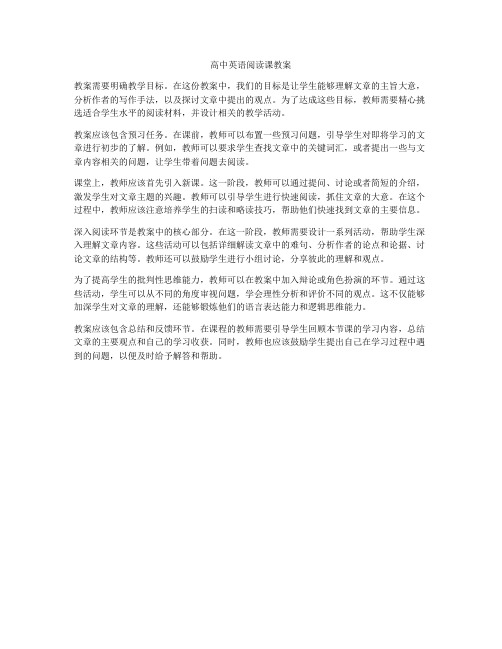
高中英语阅读课教案
教案需要明确教学目标。
在这份教案中,我们的目标是让学生能够理解文章的主旨大意,分析作者的写作手法,以及探讨文章中提出的观点。
为了达成这些目标,教师需要精心挑选适合学生水平的阅读材料,并设计相关的教学活动。
教案应该包含预习任务。
在课前,教师可以布置一些预习问题,引导学生对即将学习的文章进行初步的了解。
例如,教师可以要求学生查找文章中的关键词汇,或者提出一些与文章内容相关的问题,让学生带着问题去阅读。
课堂上,教师应该首先引入新课。
这一阶段,教师可以通过提问、讨论或者简短的介绍,激发学生对文章主题的兴趣。
教师可以引导学生进行快速阅读,抓住文章的大意。
在这个过程中,教师应该注意培养学生的扫读和略读技巧,帮助他们快速找到文章的主要信息。
深入阅读环节是教案中的核心部分。
在这一阶段,教师需要设计一系列活动,帮助学生深入理解文章内容。
这些活动可以包括详细解读文章中的难句、分析作者的论点和论据、讨论文章的结构等。
教师还可以鼓励学生进行小组讨论,分享彼此的理解和观点。
为了提高学生的批判性思维能力,教师可以在教案中加入辩论或角色扮演的环节。
通过这些活动,学生可以从不同的角度审视问题,学会理性分析和评价不同的观点。
这不仅能够加深学生对文章的理解,还能够锻炼他们的语言表达能力和逻辑思维能力。
教案应该包含总结和反馈环节。
在课程的教师需要引导学生回顾本节课的学习内容,总结文章的主要观点和自己的学习收获。
同时,教师也应该鼓励学生提出自己在学习过程中遇到的问题,以便及时给予解答和帮助。
高中英语阅读理解优秀教案

高中英语阅读理解优秀教案教学目标1. 提高学生的快速阅读与精读能力。
2. 培养学生的预测、推理及归纳总结能力。
3. 加强学生对文章结构的理解,以及主旨大意的把握。
4. 引导学生学会使用不同的阅读策略,如略读、寻读等。
5. 增强学生对细节信息的关注力和理解深度。
教学内容选择一篇适合高中生阅读水平的英文文章,内容涵盖文化、科技、社会等多个方面,确保文本具有一定的信息密度和思想深度。
教学步骤导入阶段- 开始上课前,通过提问或讨论的方式激发学生对文章主题的兴趣。
例如,可以询问学生对某一话题的了解或看法。
- 简要介绍文章的背景知识,为学生阅读全文做好铺垫。
快速阅读阶段- 要求学生快速阅读全文,抓住文章的大意。
- 通过提问检验学生的快速阅读效果,如询问文章的主旨或作者的观点。
详细解读阶段- 分段讲解文章,重点解析词汇、短语和句型结构。
- 鼓励学生提出疑问,并及时给予解答。
- 引导学生分析文章的结构和段落之间的逻辑关系。
深度探讨阶段- 组织小组讨论,让学生就文章中的某些观点或论据进行深入探讨。
- 指导学生如何从不同角度理解和分析文章内容。
策略训练阶段- 教授学生如何运用略读、寻读等阅读策略来寻找关键信息。
- 通过练习题让学生实践这些策略。
总结归纳阶段- 回顾全文,总结文章的主要内容和语言特点。
- 强调阅读理解中的关键技巧和方法。
作业布置- 布置相关的阅读理解练习题,以巩固课堂所学。
- 鼓励学生阅读额外的英文材料,提高自主学习能力。
教学反思- 课后,教师应根据学生的表现和反馈,对教学方法和内容进行调整。
- 分析哪些教学环节有效,哪些需要改进,以便在未来的教学中取得更好的效果。
高中英语阅读教学教案

高中英语阅读教学教案高中英语阅读教学教案高中英语阅读教学教案应该怎么写?教案是教师为顺利而有效地开展教学活动,根据课程标准,教学大纲和教科书要求及学生的实际情况,以课时或课题为单位,对教学内容、教学步骤、教学方法等进行的具体设计和安排的一种实用性教学文书。
下面小编给大家带来高中英语阅读教学教案,欢迎大家阅读。
高中英语阅读教学教案1LESSON PLANTime of Lesson: 45 minutesStudents: Senior Grade OneTeaching Material: How Did Postage Stamps Come Into Use Teaching Objectives:1. To train Ss' reading ability(such as guessing the meaning of new words in the context, the speed of reading.)2. To train Ss' reading comprehension(To get messages from what they read.)Teaching Points:1. Ss get used to three reading skills.2. Ss understand the given passage.Properties:Stamps, letters, postcards, work sheets, OHPTeaching Method:Communicative ApproachLesson Type:ReadingNew Words and A Phrase:postage, put forward, proposal, seal, deliver, system, postal Procedures:Step 1. Warm-up(6')1. Lead-inShow some stamps, letters and postcards and have free talk to arouse students' motivation.2. Dealing with some new wordsQ: Do you know the postage of a letter?Explain "postage", and write postage on the Bb.postage: payment for the carrying of lettersA: Fifty fen for any place in China except Hong Kong, Taiwan and Macao.Q: What do the postmen do with the letters?A: They take the letters from the postbox and carry them away to the places on the envelopes and deliver them to the addressed people.Explain "deliver", and write deliver on the Bb.deliver: take letters or goods to the addressed people.Q: Who put forward the proposal to use stamps? Use OHP to project the question onto the screen.Explain "put forward" and "proposal", and write them on the Bb.put forward: put an idea before people for thinking overproposal: sth. proposed, plan or idea, suggestionAgain: Who put forward the proposal to use stamps?Step 2. Skimming(4'30")1. InstructionsT: Now I give you a passage to read, and for the first time you should only find the answer to the question. You have only two and a half minutes to read. So don't read word for word. Read quickly. Just try to find the answer.2. Handing out the reading material and readingQ: Who put forward the proposal to use stamps.A: Rowland Hill, a schoolmaster in England.Step 3. Scanning(6')1. InstructionsT: This time I give you three minutes to read the passage. When you are reading, find the answers to the two questions.Use OHP to project the questions:1. Why was the postage high in the early nineteenth century when people did not use stamps?2. When was postage stamps first put to use?2. Reading3. Checking1) Pair work2) Class checkingAns. to Que.1. Because the post offices had to send many people to collect the postage.Ans. to Que.2. On May 6, 1840.Step 4. Full reading(21')1. InstructionsT: Now I give you ten minutes to read the passage for the third time and you should read it carefully. Before reading, let's go over the questions on the work sheet.Give Work Sheet 1 to the Ss. Explain the new words in Que.4.prevent: stop, not let sb. do sth.reuse: use againT: Try to find the answers to the questions. But don't write the answers down, you can put a sign or underline the sentences concerning the questions.3. Checking1) Group work: Checking the answers in a group of four Ss.2) Class work: Checking the answers in class.Possible Answers:1. Why were people unhappy to pay postage for letters in the early nineteenth century?Because they had to pay postage when they received letters, especially when they paid for a letter which they did not wish to receive at all. The postage was high.2. Why was it much easier for people to use stamps for postage?Because people could go to the nearby post office to buy stamps and put them on envelopes before they sent the letters.3. Why was the postage much lower using stamps?Because in this way, the post office did not need to send postmen to collect postage. It only needed to send fewer postmen to deliver letters.4. How could the post office prevent people from reusing the stamps?The post office could simply put seals on the stamps so that people could not use the stamps again.Check the understanding of the word "seal", and write it on the Bb.seal: 邮戳5. Did other countries take up the new postal system?Yes.Check the understanding of "postal" and "system", and write them on the Bb.postal: of the postsystem: a set of working ways6. Does every country in the world has its own stamps?Yes.Step 5: Rounding-off(7')1. Answering Ss' questions on the passage if any.2. Making a guided-dialogue with the information given from the passage.Hand out Work Sheet 2. Do it in pairs.3. Asking two or three pairs to read their dailogues.A possible completed dialogue:A: Oh, What a beautiful stamp!B: Yes, it's from the U.S.A..A: Do you know in the early nineteenth century people did not use stamps?B: Then how did they pay the postage?A: They had to pay the postage when they received letters.B: Was the postage very high then?A: Yes. Because the post offices had to send many people to collect the postage.B: Who put forward the proposal to use stamps?A: Rowland Hill, a schoolmaster in England.B: Why do post offices put seals on the stamps?A: They can prevent people from using the stamps again.B: When did post offices begin to sell stamps?A: On May 6, 1840.B: Thank you for telling me so many things about stamps.Step 6. Assignment(30")Ask the Ss to shorten the passage within four or five sentences after class, and to write it in their exercise books.*************************************************************Reading Material:How Did Postage Stamps Come Into UseWhen you send a letter or a postcard, you have to put stamps on the envelope or on the card. When did people first begin to use stamps? Who was the first to think of this idea?In the early nineteenth century, people did not use stamps. They had to pay postage when they received letters. They were unhappy about this, especially when they paid for a letter which they did not wish to receive at all. The postage was high at that time, because the post offices had to send many people to collect the postage.Rowland Hill, a schoolmaster in England, was the first to put forward a proposal to use stamps. He thought it would be much easier for people to use stamps to cover postage. They could go to the nearby post office to buy stamps and put them on envelopes before they sent the letters. The post office could simply put seals on the stamps so that people could not use the stamps again. In this way, the post office did not need to send postmen to collect postage. It only needed to send fewer postmen to deliver letters. That was a good idea and the government finally accepted it.On May 6, 1840, post offices throughout England began to sell stamps. Soon this new postal system was taken up by other countries. Now each country has its own stamps. And there are many people who collect stamps all over the world.Work Sheet 1:Find the answers to the following questions from the passage:1. Why were people unhappy to pay postage for letters in the early nineteenth century?2. Why was it much easier for people to use stamps for postage?3. Why was the postage much lower using stamps?4. How could the post office prevent people from reusing the stamps?5. Did other countries take up the new postal system?6. Does every country in the world has its own stamps now?Work Sheet 2:Complete the dialogue with the information you have got: A: Oh, What a beautiful stamp!B: Yes, it's from the U.S.A..A: Do you know ____________________ people did not use stamps?B: Then how did they pay the postage?A: ___________________________________________________________.B: Was the postage very high then?A: ___________________________________________________________.B: Who put forward the proposal to use stamps?A: ___________________________________________________________.B: Why do post offices put seals on the stamps?A: ___________________________________________________________.B: When did post offices begin to sell stamps?A: ___________________________________________________________.B: Thank you for telling me so many things about stamps. 高中英语阅读教学教案2Module 7 Unit 4 SharingReading A Letter HomeⅠ.Teaching ContentsModule 7 Unit4 Sharing Reading: A Letter HomeII.Analysis of teaching material本单元的话题是Sharing,本课设计的这篇课文是一个志愿者的一封家书,她在巴布亚新几内亚共和国的一个小山村教书。
高中英语阅读理解教案范文全英文

高中英语阅读理解教案范文全英文全文共3篇示例,供读者参考篇1Title: High School English Reading Comprehension Teaching PlanI. IntroductionReading comprehension plays a crucial role in English language learning. It involves various skills such as understanding the main ideas, making inferences, and interpreting the author's purpose. As high school students, it is essential for them to develop strong reading comprehension skills to succeed in their academic and professional life. This teaching plan will introduce effective strategies and activities to help high school students improve their reading comprehension abilities.II. Objectives1. To enhance students' ability to comprehend written text in English.2. To improve students' critical thinking skills through reading.3. To help students analyze and interpret different types of texts.4. To expand students' vocabulary and language proficiency.5. To develop students' confidence in reading and interpreting complex texts.III. Strategies1. Pre-reading Activities: Before reading a text, students can engage in activities such as predicting the content based on the title or images, discussing their prior knowledge on the topic, or brainstorming questions they have about the text.2. During-reading Activities: While reading, students can highlight key information, identify the main ideas and supporting details, and monitor their understanding by summarizing the text after each paragraph or section.3. Post-reading Activities: After reading, students can engage in discussions about the text, share their opinions and interpretations, answer comprehension questions, or write a summary or reflection on what they have read.4. Vocabulary Building: Introducing new vocabulary words and idioms from the text, and providing opportunities for students to use these words in context through exercises or discussions.5. Critical Thinking Exercises: Encouraging students to analyze the author's purpose, make inferences, identify biases, and evaluate the credibility of the information presented in the text.IV. Sample Lesson PlanTitle: Understanding Non-Fiction TextsObjective: To help students develop skills in comprehending and analyzing non-fiction texts.1. Warm-up (10 minutes)- Discuss the difference between fiction and non-fiction texts.- Brainstorm examples of non-fiction texts such as newspaper articles, essays, and scientific reports.2. Pre-reading Activity (10 minutes)- Show students the title and subtitles of a non-fiction article.- Ask students to make predictions about the content based on the title and subtitles.3. Reading (30 minutes)- Ask students to read the non-fiction article individually.- Encourage students to highlight key information, identify the main ideas and supporting details.- Monitor students' progress and provide support as needed.4. Post-reading Activities (20 minutes)- Divide students into small groups to discuss the main ideas of the text and share their interpretations.- Ask students to answer comprehension questions about the text.- Have students write a summary or reflection on what they have learned from the article.5. Vocabulary Building (10 minutes)- Introduce new vocabulary words from the text and discuss their meanings and usage.- Provide exercises for students to practice using the new words in sentences.6. Critical Thinking Exercise (10 minutes)- Ask students to analyze the author's purpose and identify biases in the text.- Discuss the credibility of the information presented and encourage students to form their own opinions.V. ConclusionBy implementing effective strategies and activities in teaching reading comprehension, high school students can improve their language skills, critical thinking abilities, and confidence in reading and interpreting complex texts. This teaching plan provides a framework for educators to help students develop the necessary skills to succeed in their academic and professional endeavors.篇2High School English Reading Comprehension Teaching PlanI. IntroductionReading comprehension is a vital skill for high school students to develop, as it not only enhances their academicperformance but also improves their overall language proficiency. This teaching plan aims to effectively teach high school students how to improve reading comprehension skills.II. Objectives1. To enhance students' ability to understand and interpret various types of texts.2. To improve students' vocabulary and language usage.3. To develop critical thinking skills through reading and analyzing texts.4. To help students draw connections between texts and real-life situations.III. Strategies1. Pre-reading activities: Before reading a text, engage students in activities such as brainstorming, predicting, and activating prior knowledge. This helps set the context for the text and prepares students for what they are about to read.2. During-reading activities: While students are reading a text, encourage them to use active reading strategies such as highlighting key information, making annotations, and askingquestions. This helps students stay focused and ensures better comprehension.3. Post-reading activities: After reading a text, have students engage in activities such as summarizing, analyzing, discussing, and interpreting the text. This helps reinforce comprehension and allows students to reflect on the text.IV. Lesson Plan1. Introduction to reading comprehension: Start the lesson by explaining the importance of reading comprehension and its relevance to academic success. Provide examples of how reading comprehension skills can be applied in various contexts.2. Pre-reading activity: Choose a text that is appropriate for the students' proficiency level and interests. Engage students in a pre-reading activity such as predicting the content of the text based on the title or images.3. During-reading activity: Ask students to read the text individually or in pairs and actively engage with the text by highlighting key information, making annotations, and asking questions.4. Post-reading activity: Have students discuss the text in groups, summarize the main ideas, analyze the text's structure,and draw connections to real-life situations. Encourage students to express their opinions and interpretations of the text.V. AssessmentAssess students' reading comprehension skills through various methods such as quizzes, writing assignments, class discussions, and presentations. Provide constructive feedback to help students improve their comprehension skills.VI. ConclusionReading comprehension is a crucial skill that high school students need to develop to succeed academically and in life. By implementing effective teaching strategies and engaging students in various activities, educators can help students improve their reading comprehension skills and become better readers and critical thinkers.篇3High School English Reading Comprehension Lesson PlanObjective:- To improve students' comprehension skills through reading and answering questions based on a variety of texts.- To develop students' critical thinking skills by analyzing and interpreting information from different sources.- To enhance students' vocabulary and grammar skills by exposing them to a range of reading materials.Materials:- A selection of reading passages on various topics (e.g. news articles, short stories, poems)- Reading comprehension questions for each passage- Highlighters or colored pens for marking important information- Answer keys for the comprehension questions- Whiteboard and markers for class discussionProcedure:1. Warm-up (10 minutes):- Begin the lesson by asking students to discuss in pairs or small groups about what reading comprehension means to them.- Engage the students in a short discussion about the importance of being able to understand and interpret written texts.2. Introduction to the Lesson (5 minutes):- Explain to the students that today's lesson will focus on improving their reading comprehension skills through various activities.- Provide an overview of the objectives and outcomes of the lesson to set the students' expectations.3. Reading and Comprehension Activities (40 minutes):- Divide the students into small groups and distribute the reading passages and comprehension questions.- Instruct the students to read the passage carefully, highlighting or underlining important information as they go.- Encourage students to work together in their groups to answer the comprehension questions, referring back to the text for evidence and support.- Walk around the classroom, monitoring the students' progress and providing assistance where needed.- Once the groups have completed the questions, reconvene as a class to discuss the answers and address any areas of confusion or misunderstanding.- Review the correct answers with the class and reinforce key vocabulary and grammar concepts that were covered in the passages.4. Extension Activities (15 minutes):- To further enhance the students' comprehension skills, provide additional reading passages or texts for them to work on individually or in pairs.- Encourage students to write short summaries or reflections on the texts they have read, focusing on the main ideas and key points.- Challenge the students to identify and analyze different perspectives or interpretations within the text, promoting critical thinking and analysis skills.5. Closure (5 minutes):- Conclude the lesson by reviewing the key concepts and skills that were covered during the class.- Encourage students to continue practicing their reading comprehension skills by reading regularly and engaging with a variety of texts.- Provide positive feedback and reinforcement to motivate the students and reinforce their learning.Assessment:- Assess students' comprehension skills through their responses to the reading comprehension questions and their participation in class discussions.- Monitor students' progress over time by evaluating their ability to analyze and interpret texts effectively.- Provide feedback and guidance to help students improve their reading comprehension skills and achieve their learning goals.Overall, this lesson plan is designed to help high school students develop and enhance their reading comprehension skills through engaging and interactive activities. By providing a variety of reading materials and opportunities for discussion and analysis, students will be able to improve their comprehension abilities and become more proficient readers.。
高中英语阅读理解教案范文全英文
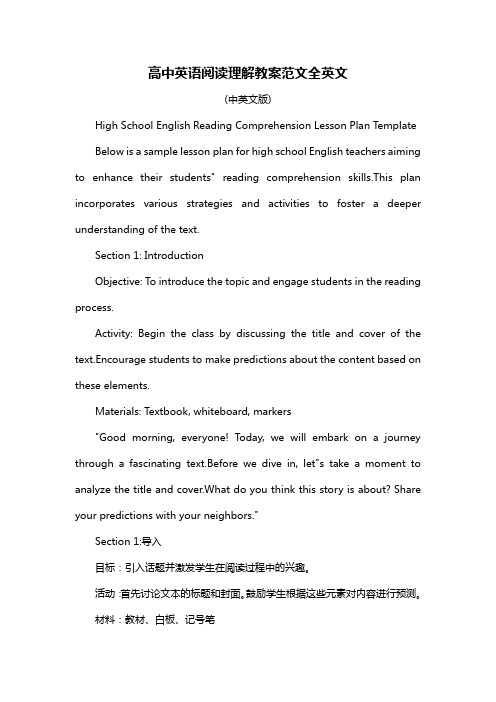
高中英语阅读理解教案范文全英文(中英文版)High School English Reading Comprehension Lesson Plan Template Below is a sample lesson plan for high school English teachers aiming to enhance their students" reading comprehension skills.This plan incorporates various strategies and activities to foster a deeper understanding of the text.Section 1: IntroductionObjective: To introduce the topic and engage students in the reading process.Activity: Begin the class by discussing the title and cover of the text.Encourage students to make predictions about the content based on these elements.Materials: Textbook, whiteboard, markers"Good morning, everyone! Today, we will embark on a journey through a fascinating text.Before we dive in, let"s take a moment to analyze the title and cover.What do you think this story is about? Share your predictions with your neighbors."Section 1:导入目标:引入话题并激发学生在阅读过程中的兴趣。
教资高中英语阅读教学设计

增加词汇量:通过大量阅读,帮助学生扩大词汇量,提高词汇运用能力。
拓展文化视野:引导学生接触不同题材和风格的英语阅读材料,了解英语国家的文化背景,拓展 国际视野。
激发学生对英语阅读的兴趣和热 情
提高学生的阅读理解能力和阅读 速度
设计合理的评价标准,包括阅读理解能力、阅读速度、词汇量等方面。 定期进行阅读成果评价,及时发现学生的不足之处,并给予指导和帮助。 鼓励学生积极参与评价过程,让他们对自己的阅读成果有更清晰的认识。 根据评价结果,调整教学方法和策略,提高阅读教学的效果。
教学目标是否明确 教学内容是否符合学生实际水平 教学方法是否能够激发学生的学习兴趣和主动性 教学评价是否能够客观、全面地反映学生的学习情况
依据教学目标和学生需求选择阅读材料 考虑学生的语言水平和兴趣爱好 选取具有思想性、教育性和文化内涵的阅读材料 注重阅读材料的多样性和丰富性
基础阅读:教授学生基本的阅读技巧和词汇,提高阅读速度和理解能力 深入阅读:引导学生深入理解文本,培养批判性思维和阅读分析能力 拓展阅读:提供丰富多样的阅读材料,鼓励学生自主选择和拓展阅读范围 跨学科阅读:结合其他学科知识,引导学生将不同领域的知识融会贯通
选取贴近学生生活实际的阅读材料,激发阅读兴趣 设计具有实际意义的阅读任务,让学生在阅读中运用所学知识解决实际问题 鼓励学生通过阅读获取信息,提高信息处理和表达能力 结合阅读材料,开展英语口语、写作等实际应用活动,促进英语综合能力的提高
跨文化意识的定 义和重要性
高中英语阅读教 学中跨文化意识 的培养目标
案例:在高中英 语阅读教学中, 教师可以先让学 生讨论与课文主 题相关的话题, 激活学生的前知, 然后引导学生从 多个角度思考问 题,提高阅读理 解能力。
高中英语小说类文章阅读理解教案
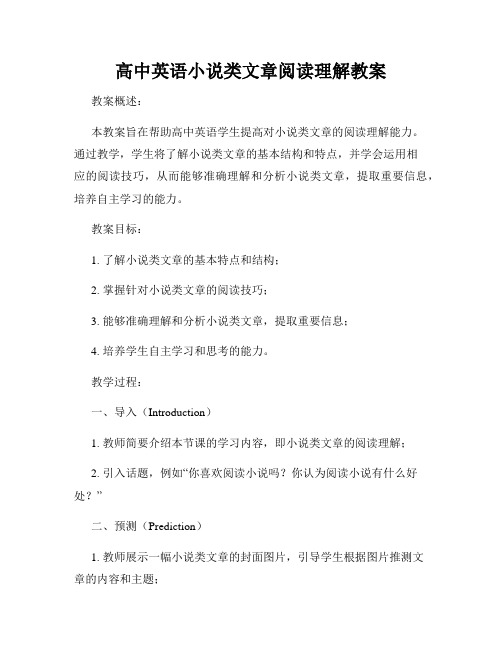
高中英语小说类文章阅读理解教案教案概述:本教案旨在帮助高中英语学生提高对小说类文章的阅读理解能力。
通过教学,学生将了解小说类文章的基本结构和特点,并学会运用相应的阅读技巧,从而能够准确理解和分析小说类文章,提取重要信息,培养自主学习的能力。
教案目标:1. 了解小说类文章的基本特点和结构;2. 掌握针对小说类文章的阅读技巧;3. 能够准确理解和分析小说类文章,提取重要信息;4. 培养学生自主学习和思考的能力。
教学过程:一、导入(Introduction)1. 教师简要介绍本节课的学习内容,即小说类文章的阅读理解;2. 引入话题,例如“你喜欢阅读小说吗?你认为阅读小说有什么好处?”二、预测(Prediction)1. 教师展示一幅小说类文章的封面图片,引导学生根据图片推测文章的内容和主题;2. 学生以小组为单位进行讨论,提出各自的预测,并与其他小组分享。
三、阅读指导(Reading Guidance)1. 教师引导学生了解小说类文章的基本结构,包括开头、主体和结尾;2. 学生分析已学过的小说类文章,掌握其常用的叙事方式和描写手法;3. 教师指导学生在阅读时注意关键词和重要细节,帮助理解整个故事情节。
四、阅读理解(Reading Comprehension)1. 学生独立阅读一篇小说类文章;2. 学生回答与文章内容相关的问题,包括主旨、人物、情节等方面;3. 学生将回答的问题进行整理,形成文章摘要或概括。
五、讨论与交流(Discussion and Communication)1. 学生以小组为单位进行讨论,互相交流自己对文章的理解和摘要;2. 每个小组派出一名代表进行汇报,分享各组的讨论成果。
六、总结与拓展(Summary and Extension)1. 教师对本节课的学习内容进行总结,强调小说类文章的阅读技巧;2. 教师提供更多小说类文章的阅读材料,供学生课后拓展阅读。
教学反思:通过本节课的教学,学生不仅了解了小说类文章的基本结构和特点,还学会了阅读技巧,增强了对小说类文章的阅读理解能力。
英语阅读理解公开课教案高中
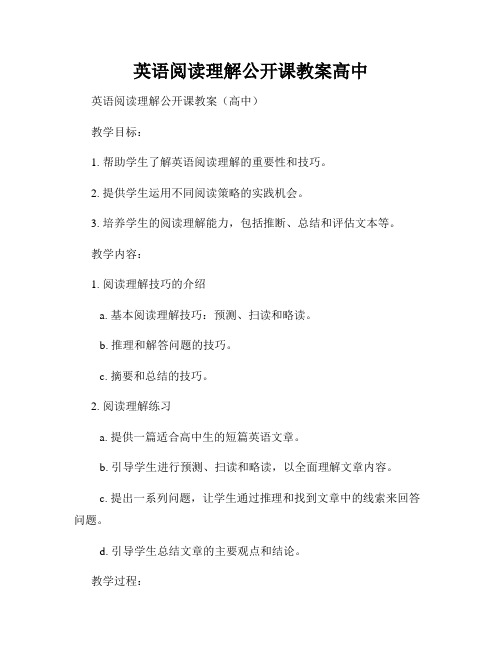
英语阅读理解公开课教案高中英语阅读理解公开课教案(高中)教学目标:1. 帮助学生了解英语阅读理解的重要性和技巧。
2. 提供学生运用不同阅读策略的实践机会。
3. 培养学生的阅读理解能力,包括推断、总结和评估文本等。
教学内容:1. 阅读理解技巧的介绍a. 基本阅读理解技巧:预测、扫读和略读。
b. 推理和解答问题的技巧。
c. 摘要和总结的技巧。
2. 阅读理解练习a. 提供一篇适合高中生的短篇英语文章。
b. 引导学生进行预测、扫读和略读,以全面理解文章内容。
c. 提出一系列问题,让学生通过推理和找到文章中的线索来回答问题。
d. 引导学生总结文章的主要观点和结论。
教学过程:1. 创设情境,引入话题在开始本节课之前,教师可以向学生简要介绍英语阅读理解的重要性,并提问学生他们在日常生活中有何困难。
2. 介绍阅读理解技巧a. 预测:让学生通过阅读标题、副标题和首段,猜测文章主题和内容。
b. 扫读:要求学生快速阅读全文,获取整体理解,并注意段落标题以及文字格式变化的线索。
c. 略读:鼓励学生在继续阅读之前,先浏览全文段落,从而了解文章的结构和组织方式。
3. 演示阅读理解技巧配合一篇短篇英语文章,教师可以演示如何使用上述技巧来理解文章,并解答一些与文章相关的问题。
4. 学生练习阅读理解技巧学生独立阅读一篇短篇英语文章,然后根据老师提出的问题,应用上述技巧进行阅读理解,并完成问题解答。
5. 学生总结文章的主要观点和结论学生可以用自己的语言总结文章的主要观点和结论,并与同学分享。
6. 教师评价和反馈教师对学生的阅读理解技巧运用和问题解答进行评价,并给予适当的反馈。
教学资源:1. 适合高中生的短篇英语文章。
2. 学生练习用的问题列表。
3. 提供学生总结的示范。
教学评估:1. 教师观察学生在阅读理解过程中使用的技巧和策略。
2. 对学生的问题解答和总结进行评估,查看他们对文章的理解程度。
3. 学生之间的互评,让他们根据彼此的回答和总结,提供反馈和建议。
高中英语阅读教学教案设计
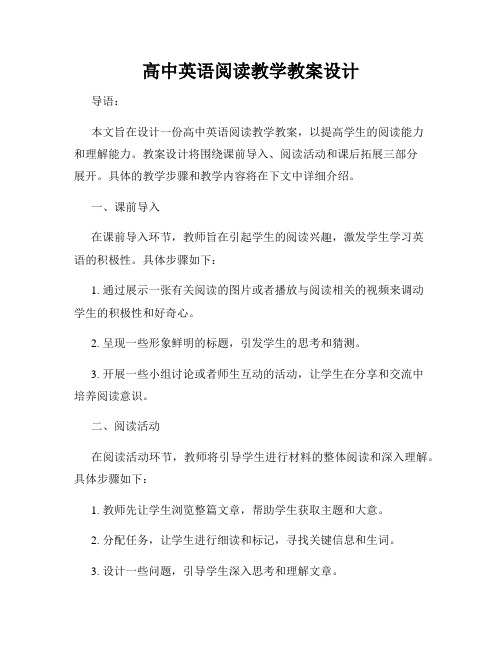
高中英语阅读教学教案设计导语:本文旨在设计一份高中英语阅读教学教案,以提高学生的阅读能力和理解能力。
教案设计将围绕课前导入、阅读活动和课后拓展三部分展开。
具体的教学步骤和教学内容将在下文中详细介绍。
一、课前导入在课前导入环节,教师旨在引起学生的阅读兴趣,激发学生学习英语的积极性。
具体步骤如下:1. 通过展示一张有关阅读的图片或者播放与阅读相关的视频来调动学生的积极性和好奇心。
2. 呈现一些形象鲜明的标题,引发学生的思考和猜测。
3. 开展一些小组讨论或者师生互动的活动,让学生在分享和交流中培养阅读意识。
二、阅读活动在阅读活动环节,教师将引导学生进行材料的整体阅读和深入理解。
具体步骤如下:1. 教师先让学生浏览整篇文章,帮助学生获取主题和大意。
2. 分配任务,让学生进行细读和标记,寻找关键信息和生词。
3. 设计一些问题,引导学生深入思考和理解文章。
4. 帮助学生掌握阅读策略,如扫读、略读和精读。
5. 引导学生进行词汇和语法的分析,培养学生的语言运用能力。
三、课后拓展在课后拓展环节,教师将组织学生进行一些拓展活动,以促进学生在阅读中的自主学习和思考。
具体步骤如下:1. 布置一些与文章内容相关的作业,如写一篇小短文、设计一个续写、形成自己的问题等,以检验学生对文章的理解和运用能力。
2. 推荐一些相关的阅读材料,鼓励学生拓宽阅读视野。
3. 鼓励学生与同学分享自己的阅读心得和体会,培养合作学习的氛围。
结语:通过本节课的阅读教学活动,学生应该能够提高他们的阅读能力和理解能力,同时也能培养他们的自主学习和合作学习的能力。
希望通过本教案设计,能够为高中英语阅读教学提供一种有效的教学参考。
高三英语高级阅读理解技巧教案

高三英语高级阅读理解技巧教案一、引言英语高级阅读理解是高中英语考试中的难点,也是需要高级技巧来应对的部分。
本教案将介绍一些高级阅读理解技巧,帮助同学们在高考中取得更好的成绩。
二、技巧一:快速浏览在阅读一篇长篇文章之前,快速浏览是非常重要的一步。
通过快速浏览,我们可以获取文章的大致结构和主题,对于理解全文非常有帮助。
技巧:1.阅读标题和副标题,了解文章的大致内容;2.浏览段落首句和末句,获取段落的大意;3.略读每个段落的第一句,形成整篇文章的梗概。
三、技巧二:注意关键词在高级阅读理解中,关键词是理解文章的关键。
通过注意关键词,我们可以更好地理解文章的要点和细节。
技巧:1.注意文章中的名词、动词、形容词等词语,它们通常承载着重要信息;2.注意文章中出现的数字、地点、人物等特殊信息,它们可能与问题或答案有关;3.注意文章中的转折词、连接词等,它们可以帮助理解文章的逻辑关系。
四、技巧三:掌握修辞手法修辞手法在英语文章中常常使用,掌握常见的修辞手法可以帮助我们更好地理解文章的含义。
技巧:1.注意文章中的比喻、拟人、夸张等修辞手法,理解其隐含的意义;2.注意文章中的转折、对比、因果关系等修辞手法,理解文章的逻辑推理;3.注意文章中的排比、重复、反复等修辞手法,理解作者的强调和表达方式。
五、技巧四:划分段落有时候,一篇长篇文章可能包含多个段落,每个段落都有各自的主题和论证。
划分段落可以帮助我们更好地理解文章的结构和逻辑。
技巧:1.注意段落的开头和结尾,了解段落的主题和观点;2.注意段落中的过渡词,理解段落与段落之间的联系;3.注意段落中的细节和例子,帮助理解段落的论证和论点。
六、技巧五:善用上下文在高级阅读理解中,上下文是我们理解词义和句子含义的重要依据。
善于利用上下文可以帮助我们更好地理解文章的意思。
技巧:1.注意上下文中的同义词、近义词、反义词等,帮助理解词语的含义;2.注意上下文中的解释、举例、定义等,帮助理解句子的意思;3.注意上下文中的因果关系、转折关系等,理解句子的逻辑关系。
高中英语阅读教案
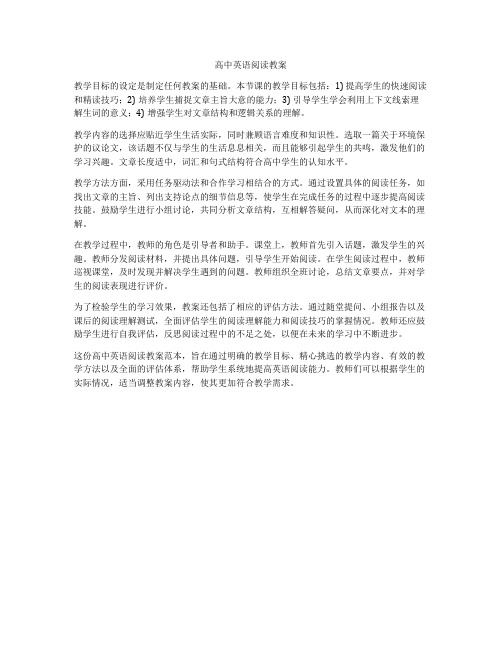
高中英语阅读教案教学目标的设定是制定任何教案的基础。
本节课的教学目标包括:1) 提高学生的快速阅读和精读技巧;2) 培养学生捕捉文章主旨大意的能力;3) 引导学生学会利用上下文线索理解生词的意义;4) 增强学生对文章结构和逻辑关系的理解。
教学内容的选择应贴近学生生活实际,同时兼顾语言难度和知识性。
选取一篇关于环境保护的议论文,该话题不仅与学生的生活息息相关,而且能够引起学生的共鸣,激发他们的学习兴趣。
文章长度适中,词汇和句式结构符合高中学生的认知水平。
教学方法方面,采用任务驱动法和合作学习相结合的方式。
通过设置具体的阅读任务,如找出文章的主旨、列出支持论点的细节信息等,使学生在完成任务的过程中逐步提高阅读技能。
鼓励学生进行小组讨论,共同分析文章结构,互相解答疑问,从而深化对文本的理解。
在教学过程中,教师的角色是引导者和助手。
课堂上,教师首先引入话题,激发学生的兴趣。
教师分发阅读材料,并提出具体问题,引导学生开始阅读。
在学生阅读过程中,教师巡视课堂,及时发现并解决学生遇到的问题。
教师组织全班讨论,总结文章要点,并对学生的阅读表现进行评价。
为了检验学生的学习效果,教案还包括了相应的评估方法。
通过随堂提问、小组报告以及课后的阅读理解测试,全面评估学生的阅读理解能力和阅读技巧的掌握情况。
教师还应鼓励学生进行自我评估,反思阅读过程中的不足之处,以便在未来的学习中不断进步。
这份高中英语阅读教案范本,旨在通过明确的教学目标、精心挑选的教学内容、有效的教学方法以及全面的评估体系,帮助学生系统地提高英语阅读能力。
教师们可以根据学生的实际情况,适当调整教案内容,使其更加符合教学需求。
高中英语阅读理解教案
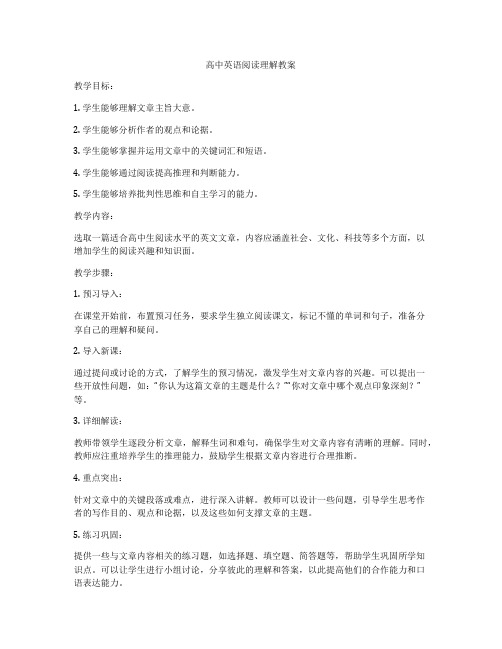
高中英语阅读理解教案教学目标:1. 学生能够理解文章主旨大意。
2. 学生能够分析作者的观点和论据。
3. 学生能够掌握并运用文章中的关键词汇和短语。
4. 学生能够通过阅读提高推理和判断能力。
5. 学生能够培养批判性思维和自主学习的能力。
教学内容:选取一篇适合高中生阅读水平的英文文章,内容应涵盖社会、文化、科技等多个方面,以增加学生的阅读兴趣和知识面。
教学步骤:1. 预习导入:在课堂开始前,布置预习任务,要求学生独立阅读课文,标记不懂的单词和句子,准备分享自己的理解和疑问。
2. 导入新课:通过提问或讨论的方式,了解学生的预习情况,激发学生对文章内容的兴趣。
可以提出一些开放性问题,如:“你认为这篇文章的主题是什么?”“你对文章中哪个观点印象深刻?”等。
3. 详细解读:教师带领学生逐段分析文章,解释生词和难句,确保学生对文章内容有清晰的理解。
同时,教师应注重培养学生的推理能力,鼓励学生根据文章内容进行合理推断。
4. 重点突出:针对文章中的关键段落或难点,进行深入讲解。
教师可以设计一些问题,引导学生思考作者的写作目的、观点和论据,以及这些如何支撑文章的主题。
5. 练习巩固:提供一些与文章内容相关的练习题,如选择题、填空题、简答题等,帮助学生巩固所学知识点。
可以让学生进行小组讨论,分享彼此的理解和答案,以此提高他们的合作能力和口语表达能力。
6. 拓展提升:为了培养学生的批判性思维,教师可以提出一些挑战性的问题,如:“你同意作者的观点吗?为什么?”“如果你是作者,会如何论证你的观点?”等。
这些问题可以促使学生从不同角度思考问题,提高他们的分析和判断能力。
7. 作业布置:布置适当的家庭作业,如写一篇关于文章主题的短文,或者寻找与文章主题相关的额外阅读材料,以加强学生的自主学习能力。
8. 反馈总结:在下一节课上,教师应该对学生的作业进行点评,总结本次课程的学习成果,并对学生的学习表现给予积极的反馈。
高中英语阅读课教案
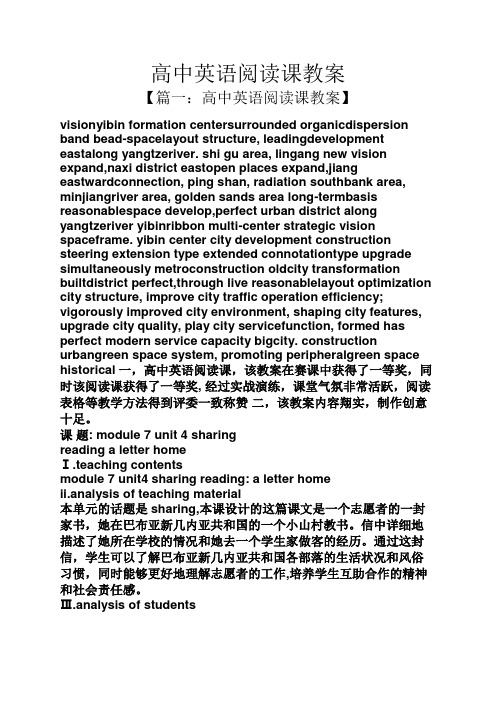
高中英语阅读课教案【篇一:高中英语阅读课教案】visionyibin formation centersurrounded organicdispersion band bead-spacelayout structure, leadingdevelopment eastalong yangtzeriver. shi gu area, lingang new vision expand,naxi district eastopen places expand,jiang eastwardconnection, ping shan, radiation southbank area, minjiangriver area, golden sands area long-termbasis reasonablespace develop,perfect urban district along yangtzeriver yibinribbon multi-center strategic vision spaceframe. yibin center city development construction steering extension type extended connotationtype upgrade simultaneously metroconstruction oldcity transformation builtdistrict perfect,through live reasonablelayout optimization city structure, improve city traffic operation efficiency; vigorously improved city environment, shaping city features, upgrade city quality, play city servicefunction, formed has perfect modern service capacity bigcity. construction urbangreen space system, promoting peripheralgreen space historical一,高中英语阅读课,该教案在赛课中获得了一等奖,同时该阅读课获得了一等奖, 经过实战演练,课堂气氛非常活跃,阅读表格等教学方法得到评委一致称赞二,该教案内容翔实,制作创意十足。
英语课教案二:高中阅读理解练习

英语课教案二:高中阅读理解练习一、背景和目标在高中英语教学中,阅读理解是非常重要的一项内容。
因为英语阅读已经成为我们生活和工作中不可缺少的一部分,所以教师需要通过阅读理解练习,帮助学生提高语阅读叙事、议论和说明型文章的能力。
二、教学过程1.开始前引导学生主动思考和猜测文章标题,以此激发学生的兴趣和好奇心。
然后给出一些关键词,激活学生的相关经验知识。
2.阅读和理解学生进入阅读环节。
在这一环节中,学生可以自主阅读,教师也可以提供语言点和课文理解帮助学生理解文章。
3.理解和解决问题此环节是阅读理解的重点。
教师可以设置一些问题,引导学生理解文章,并解答问题,检查学生的阅读理解能力。
问题设置应注意:既要简单,又要贫困,有助于学生回溯文中答案的信息。
此外,问题解答的过程可以为学生提供文章信息的预演和掌握方法。
4.总结和反思学生完成了问题解答后,教师可以进行回顾和总结。
让学生将文中易犯的错误、易混淆的语言点、对问题理解不够彻底的问题等总结出来。
教师要引导学生彻底理解文章,找出其中的深层次信息,并整合文章中的语言知识。
三、教学策略与技巧1.激活学习者的知识和经验先探讨一些对文章内容有所帮助的关键词或词汇,可以涵盖学生的生活经验和知识体系。
2.提供语言学习机会在教学过程中,要将语言点与文章联系起来,让学生具有实践性。
例如,可以针对阅读理解所使用的句型或语言点进行练习。
3.指导学生处理海量信息学生在阅读理解过程中会受到文本内容、语言信息、题目要求等多方面的影响,要指导学生掌握信息的处理方法,循序渐进地进行阅读理解。
4.鼓励阅读,促进思考阅读有助于学生积累语言知识,但是,阅读不仅仅是为了积累语言知识,还可以在不断地阅读和思考中提高学生的加工语言信息和解决问题的能力。
四、注意事项1.适当引导学生在阅读理解过程中,教师应适当引导学生,让学生更好地理解文章。
例如,指导学生发现文本中的联词,帮助学生构建文本的逻辑关系。
2.在某种程度上解释文本在阅读理解中,教师应根据学生的情况,选取一些组织性或语言性较难的问题,给与更细致的解释,引导学生更好地理解文章。
高中英语阅读理解题教案

高中英语阅读理解题教案_高中英语阅读教案高中英语教案应当怎么写呢,详细来讲一份正规的高中英语教案应当是怎样一种格式呢,想要知道的抓紧往下看。
下面是高中英语教案的格式,供广阔的教师参考。
一、教材分析:Analysis of the Teaching material二、教学目标:Teaching alms and demands:三、教学重难点:Teaching keys and difficulties:四、教学方法:Teaching methods:五、教学工具:Teaching aids:六、教学过程:Teaching procedures:七、板书设计:Blackboard Design.八教学评价与反思一份正规的高中英语教案主要应当包含上面的八个要点,也是作为一份教案应当具有的根本格式。
高中英语《A Master of Nonverbal Humor》教案Teaching goals:1. The students will be able to know some words and expressionsto describe a person’s appearance.2. The students will be able to know something about Charlie Chaplin’s life experiences, charming character and convincing performance.3. The students will be able to further understand the meaning of laughter.4. The students will be able to have a better command of summarizing a short passage by picking out key words from the passage.5. The students will be able to master a framework of introducing a person.6. The students will experience the reading strategy of summarizing, analyzing, inferring, and evaluating.Teaching process:Step 1: lead-inHave a taste of English humor by introducing two letters between Albert Einstein and Charlie Chaplin.Albert Einstein:You are really great. Everyone understands your film although there is no line.Charlie Chaplin:You are even greater although nobody understands your theory.设计意图:教师用简短的语言概括了爱因斯坦和卓别林之间的一次书信交往。
高中英语阅读课优秀教案
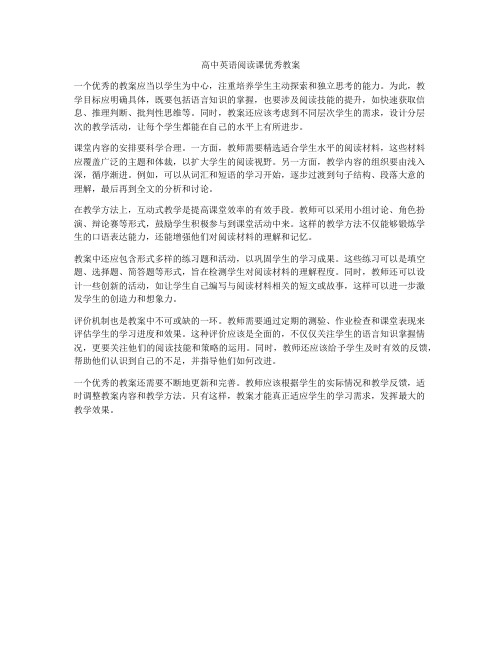
高中英语阅读课优秀教案一个优秀的教案应当以学生为中心,注重培养学生主动探索和独立思考的能力。
为此,教学目标应明确具体,既要包括语言知识的掌握,也要涉及阅读技能的提升,如快速获取信息、推理判断、批判性思维等。
同时,教案还应该考虑到不同层次学生的需求,设计分层次的教学活动,让每个学生都能在自己的水平上有所进步。
课堂内容的安排要科学合理。
一方面,教师需要精选适合学生水平的阅读材料,这些材料应覆盖广泛的主题和体裁,以扩大学生的阅读视野。
另一方面,教学内容的组织要由浅入深,循序渐进。
例如,可以从词汇和短语的学习开始,逐步过渡到句子结构、段落大意的理解,最后再到全文的分析和讨论。
在教学方法上,互动式教学是提高课堂效率的有效手段。
教师可以采用小组讨论、角色扮演、辩论赛等形式,鼓励学生积极参与到课堂活动中来。
这样的教学方法不仅能够锻炼学生的口语表达能力,还能增强他们对阅读材料的理解和记忆。
教案中还应包含形式多样的练习题和活动,以巩固学生的学习成果。
这些练习可以是填空题、选择题、简答题等形式,旨在检测学生对阅读材料的理解程度。
同时,教师还可以设计一些创新的活动,如让学生自己编写与阅读材料相关的短文或故事,这样可以进一步激发学生的创造力和想象力。
评价机制也是教案中不可或缺的一环。
教师需要通过定期的测验、作业检查和课堂表现来评估学生的学习进度和效果。
这种评价应该是全面的,不仅仅关注学生的语言知识掌握情况,更要关注他们的阅读技能和策略的运用。
同时,教师还应该给予学生及时有效的反馈,帮助他们认识到自己的不足,并指导他们如何改进。
一个优秀的教案还需要不断地更新和完善。
教师应该根据学生的实际情况和教学反馈,适时调整教案内容和教学方法。
只有这样,教案才能真正适应学生的学习需求,发挥最大的教学效果。
高中英语阅读教学设计教资
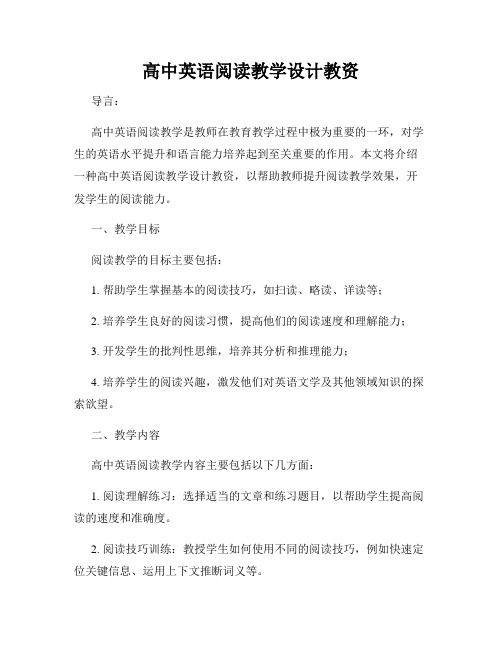
高中英语阅读教学设计教资导言:高中英语阅读教学是教师在教育教学过程中极为重要的一环,对学生的英语水平提升和语言能力培养起到至关重要的作用。
本文将介绍一种高中英语阅读教学设计教资,以帮助教师提升阅读教学效果,开发学生的阅读能力。
一、教学目标阅读教学的目标主要包括:1. 帮助学生掌握基本的阅读技巧,如扫读、略读、详读等;2. 培养学生良好的阅读习惯,提高他们的阅读速度和理解能力;3. 开发学生的批判性思维,培养其分析和推理能力;4. 培养学生的阅读兴趣,激发他们对英语文学及其他领域知识的探索欲望。
二、教学内容高中英语阅读教学内容主要包括以下几方面:1. 阅读理解练习:选择适当的文章和练习题目,以帮助学生提高阅读的速度和准确度。
2. 阅读技巧训练:教授学生如何使用不同的阅读技巧,例如快速定位关键信息、运用上下文推断词义等。
3. 阅读策略指导:教授学生如何制定阅读计划,分析文章结构,有针对性地提高阅读理解能力。
4. 阅读材料选择:选择与学生年龄和学科相关的阅读材料,如文学作品、科普文章、历史故事等。
三、教学方法为了达到上述教学目标,教师可以采用以下教学方法:1. 互动式教学:教师与学生积极互动,通过提问、讨论、角色扮演等活动促进学生的思维发展和交流能力。
2. 小组合作学习:将学生分组,组内合作完成阅读任务,相互讨论和分享观点,提高思维碰撞和合作意识。
3. 案例分析:选择真实的阅读案例进行分析,引导学生运用所学知识解决问题,提高其解决实际问题的能力。
4. 多媒体辅助教学:利用多媒体技术和网络资源,引导学生进行电子图书和网络文章的阅读,扩展学生的阅读广度和深度。
四、教学评价为了评价教学的效果,教师可以采用以下评价方式:1. 课堂测试:设置小测验或作业,考察学生对阅读材料的理解和运用阅读技巧的能力。
2. 作品展示:要求学生用英语写读后感、摘录重点句子、总结文章结构等,展示他们的阅读成果。
3. 互评互鉴:学生进行小组互评,互相提出建议和改进意见,促进学生在阅读过程中的自我反思和学习成长。
- 1、下载文档前请自行甄别文档内容的完整性,平台不提供额外的编辑、内容补充、找答案等附加服务。
- 2、"仅部分预览"的文档,不可在线预览部分如存在完整性等问题,可反馈申请退款(可完整预览的文档不适用该条件!)。
- 3、如文档侵犯您的权益,请联系客服反馈,我们会尽快为您处理(人工客服工作时间:9:00-18:30)。
高中英语阅读理解教案
引言:
高中英语阅读理解是英语学习的重要组成部分,也是考试中的重点之一。
许多学生在阅读理解中遇到困难,往往是由于缺乏正确的阅读策略和技巧。
因此,教师需要设计一套有针对性的教案,帮助学生提高阅读理解能力。
一、培养学生的预测能力
在阅读理解中,预测能力是非常重要的一个技巧。
教师可以采取以下方式进行培养:
1. 给学生提供文章或段落的标题,让他们猜测文章中可能会出现的内容。
2. 在课堂上进行预测活动,通过观察图片或听一段录音,让学生尽可能多地预测即将听到或看到的信息。
二、提高学生的快速阅读能力
快速阅读是阅读理解中的基本技能之一。
为了帮助学生提高快速阅读能力,教师可以采取以下步骤:
1. 给学生提供一些练习材料,让他们用限定的时间尽可能多地阅读和理解。
2. 引导学生掌握一些快速阅读的技巧,如快速浏览文章的开头和结尾,以及识别关键词以推测文章的主题。
三、加强学生的词汇积累
词汇量的积累对于理解文章的意思至关重要。
教师可以采取以下措施来加强学生的词汇积累:
1. 给学生提供丰富的词汇练习,如填空、选词等。
2. 引导学生使用词根、词缀等技巧来推测单词的意思。
3. 鼓励学生积极阅读英语原版的书籍、报纸和杂志,提高词汇量和阅读理解能力。
四、培养学生的推理能力
阅读理解中常常涉及到一些推理题,教师可以通过以下方式培养学生的推理能力:
1. 给学生提供一些推理练习题,引导他们通过文章中的线索来推测相关的信息。
2. 引导学生从文章的上下文中推理出未知词汇的意思。
五、提高学生的阅读速度
阅读速度是阅读理解中的关键。
为了提高学生的阅读速度,教师可以采取以下
方法:
1. 给学生提供一些快速阅读的练习,要求他们在规定的时间内尽可能多地阅读
和理解文章。
2. 鼓励学生每天进行一定时间的阅读练习,逐渐提高他们的阅读速度。
六、引导学生进行有效的阅读注释
阅读注释是一种提高阅读理解能力的有效方法。
教师可以通过以下步骤引导学
生进行有效的阅读注释:
1. 教授学生如何标记和注释关键词、重点句子和段落。
2. 引导学生将注释与问题结合起来,帮助他们更好地理解文章的意思。
七、培养学生的阅读细节把握能力
阅读理解中常常涉及到一些细节问题,教师可以通过以下方式培养学生的细节把握能力:
1. 给学生提供一些细节问题的练习,引导他们仔细阅读文章,把握细节信息。
2. 引导学生从文章中寻找关键词和线索,帮助他们更准确地回答问题。
八、鼓励学生进行多样化的阅读
多样化的阅读可以帮助学生对不同类型的文章有更深入的理解。
教师可以采取以下措施鼓励学生进行多样化的阅读:
1. 给学生提供不同类型的文章,如新闻报道、社论、科学文献等,帮助他们扩大阅读的广度。
2. 引导学生进行小组讨论,分享自己在不同类型文章中遇到的问题和经验。
九、帮助学生理解各种文体和修辞手法
不同的文体和修辞手法对于理解文章的意义和目的至关重要。
教师可以通过以下方式帮助学生理解各种文体和修辞手法:
1. 给学生提供一些文体和修辞手法的例子,让他们分析其在文章中的作用和效果。
2. 引导学生进行多种文体的练习,如新闻、说明文、议论文等,帮助他们更好地理解和运用不同的文体和修辞手法。
十、教授学生答题技巧
答题技巧对于阅读理解的成功至关重要。
教师可以通过以下方式教授学生答题技巧:
1. 教授学生如何快速扫描问题并找到相关的文章段落。
2. 引导学生阅读问题的方式,帮助他们理解问题的意义和要求。
总结:
通过以上的教学方法和技巧,教师可以帮助学生提高阅读理解能力。
同时,学生也需要在课后积极进行练习和自主阅读,才能够不断提高自己的阅读水平。
阅读理解的提高将为学生未来的学习和工作打下坚实的基础。
